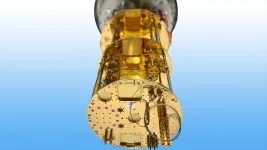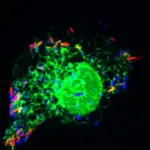In the emptiness of space, Voyager I detects plasma 'hum'
2021-05-10
(Press-News.org) ITHACA, N.Y. - Voyager 1 - one of two sibling NASA spacecraft launched 44 years ago and now the most distant human-made object in space - still works and zooms toward infinity.
The craft has long since zipped past the edge of the solar system through the heliopause - the solar system's border with interstellar space - into the interstellar medium. Now, its instruments have detected the constant drone of interstellar gas (plasma waves), according to Cornell University-led research published in Nature Astronomy.
Examining data slowly sent back from more than 14 billion miles away, Stella Koch Ocker, a Cornell doctoral student in astronomy, has uncovered the emission. "It's very faint and monotone, because it is in a narrow frequency bandwidth," Ocker said. "We're detecting the faint, persistent hum of interstellar gas."
This work allows scientists to understand how the interstellar medium interacts with the solar wind, Ocker said, and how the protective bubble of the solar system's heliosphere is shaped and modified by the interstellar environment.
Launched in September 1977, the Voyager 1 spacecraft flew by Jupiter in 1979 and then Saturn in late 1980. Travelling at about 38,000 mph, Voyager 1 crossed the heliopause in August 2012.
After entering interstellar space, the spacecraft's Plasma Wave System detected perturbations in the gas. But, in between those eruptions - caused by our own roiling sun - researchers have uncovered a steady, persistent signature produced by the tenuous near-vacuum of space.
"The interstellar medium is like a quiet or gentle rain," said senior author James Cordes, the George Feldstein Professor of Astronomy. "In the case of a solar outburst, it's like detecting a lightning burst in a thunderstorm and then it's back to a gentle rain."
Ocker believes there is more low-level activity in the interstellar gas than scientists had previously thought, which allows researchers to track the spatial distribution of plasma - that is, when it's not being perturbed by solar flares.
Cornell research scientist Shami Chatterjee explained how continuous tracking of the density of interstellar space is important. "We've never had a chance to evaluate it. Now we know we don't need a fortuitous event related to the sun to measure interstellar plasma," Chatterjee said. "Regardless of what the sun is doing, Voyager is sending back detail. The craft is saying, 'Here's the density I'm swimming through right now. And here it is now. And here it is now. And here it is now.' Voyager is quite distant and will be doing this continuously."
Voyager 1 left Earth carrying a Golden Record created by a committee chaired by the late Cornell professor Carl Sagan, as well as mid-1970s technology. To send a signal to Earth, it took 22 watts, according to NASA's Jet Propulsion Laboratory. The craft has almost 70 kilobytes of computer memory and - at the beginning of the mission - a data rate of 21 kilobits per second.
Due to the 14-billion-mile distance, the communication rate has since slowed to 160-bits-per-second, or about half a 300-baud rate.
INFORMATION:
NASA, the Jet Propulsion Laboratory and the National Science Foundation supported the work. Cordes, Chatterjee and Ockler are members of Cornell's Carl Sagan Institute.
ELSE PRESS RELEASES FROM THIS DATE:
2021-05-10
Speech problems such as stammering or stuttering plague millions of people worldwide, including 3 million Americans. President Biden himself struggled with stuttering as a child and has largely overcome it with speech therapy. The cause of stuttering has long been a mystery, but researchers at Tufts University are beginning to unlock its causes and a strategy to develop potential treatments using a very curious model system - songbirds. In a study published today in Current Biology, the researchers were able to observe that a simple, reversible pharmacological treatment in zebra finches can stimulate rapid firing in a part of the brain that leads ...
2021-05-10
Numerous disease development processes are linked to epigenetic modulation. One protein involved in the process of modulation and identified as an important cancer marker is BRD4. A recent study by the research group of Giulio Superti-Furga, Principal Investigator and Scientific Director at the CeMM Research Center for Molecular Medicine of the Austrian Academy of Sciences, now shows that the supply of purines as well as the purine synthesis of a cell can influence BRD4 activity and thus play a role in the carcinogenesis process. The findings were published in Nature Metabolism.
Chromatin is a ...
2021-05-10
New Curtin University research has found a bias among scientists toward colourful and visually striking plants, means they are more likely to be chosen for scientific study and benefit from subsequent conservation efforts, regardless of their ecological importance.
Co-author John Curtin Distinguished Professor Kingsley Dixon from Curtin's School of Molecular and Life Sciences was part of an international team that looked for evidence of an aesthetic bias among scientists by analysing 113 plant species found in global biodiversity hotspot the Southwestern Alps and mentioned in 280 research papers published between 1975 and 2020.
Professor Dixon said the study tested whether there was a relationship between research focus on plant species and characteristics ...
2021-05-10
In cancer, a lot of biology goes awry: Genes mutate, molecular processes change dramatically, and cells proliferate uncontrollably to form entirely new tissues that we call tumors. Multiple things go wrong at different levels, and this complexity is partly what makes cancer so difficult to research and treat.
So it stands to reason that cancer researchers focus their attention where all cancers begin: the genome. If we can understand what happens at the level of DNA, then we can perhaps one day not just treat but even prevent cancers altogether.
This drive has led a ...
2021-05-10
In the last few years, several technology companies including Google, Microsoft, and IBM, have massively invested in quantum computing systems based on microwave superconducting circuit platforms in an effort to scale them up from small research-oriented systems to commercialized computing platforms. But fulfilling the potential of quantum computers requires a significant increase in the number of qubits, the building blocks of quantum computers, which can store and manipulate quantum information.
But quantum signals can be contaminated by thermal noise generated by the movement of electrons. To prevent this, superconducting quantum systems must operate at ultra-low temperatures - less ...
2021-05-10
NEW YORK, NY (May 10, 2021)--Scientists have discovered that many esophageal cancers turn on ancient viral DNA that was embedded in our genome hundreds of millions of years ago.
"It was surprising," says Adam Bass, MD, the Herbert and Florence Irving Professor of Medicine at Columbia University Vagelos College of Physicians and Surgeons and Herbert Irving Comprehensive Cancer Center, who led the study published May 10 in Nature Genetics.
"We weren't specifically searching for the viral elements, but the finding opens up a huge new array of potential cancer targets that I think will be extremely exciting as ways to enhance immunotherapy."
Fossil ...
2021-05-10
DALLAS - May 10, 2021 - Scientists at UT Southwestern have discovered a key protein that helps the bacteria that causes Legionnaires' disease to set up house in the cells of humans and other hosts. The findings, published in Science, could offer insights into how other bacteria are able to survive inside cells, knowledge that could lead to new treatments for a wide variety of infections.
"Many infectious bacteria, from listeria to chlamydia to salmonella, use systems that allow them to dwell within their host's cells," says study leader Vincent Tagliabracci, Ph.D., assistant professor of molecular biology at UTSW and member of the Harold C. Simmons Comprehensive Cancer Center. "Better understanding the tools they use to make this happen is teaching us some interesting biochemistry and ...
2021-05-10
Many have assumed that the rates of major abdominal surgeries in adults over 65 is increasing over time as the U.S. population ages and as new technology renders surgical procedures safer for older adults. Contrary to this popular belief, a new study from the University of Chicago Medicine found the frequency of abdominal surgery in older adults is decreasing, especially among adults over the age of 85. The study, which examined data from 2002 to 2014, was published May 10 in the Journal of the American Geriatric Society.
While the research was not able to determine the exact reasons for this shift, the results indicate that improvements ...
2021-05-10
The relationship a dog has with its owner is related to its stress level. This is the conclusion of a newly published study from Linköping University, Sweden. The results, published in the journal Scientific Reports, also suggest that the link between stress and the owner's personality traits differs between dog breeds.
Researchers at Linköping University have investigated whether the stress levels of dogs are affected by the people they live with. Stress levels for the past several months can be determined in both dogs and humans by measuring the levels of stress hormone stored in hairs as they grow.
The researchers have collected hair from both dogs and owners, and measured levels of cortisol, the most important stress hormone, in them. They were interested in whether there ...
2021-05-10
For organizations to reach their potential, they must leverage the expertise of their employees. However, research demonstrates that lower-status employees may not be heard because their "voices" are more likely to be ignored.
New research from the University of Notre Dame is the first to show that peers can help boost marginalized voices, and at the same time benefit their own status, all while helping their organization realize the potential of its employees' diverse perspectives.
Publicly endorsing -- or amplifying -- another person's contribution, while giving attribution to that person, enhances the status of both parties, according to "Amplifying Voice in Organizations," ...
LAST 30 PRESS RELEASES:
[Press-News.org] In the emptiness of space, Voyager I detects plasma 'hum'




